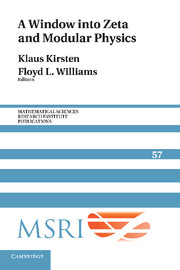Book contents
- Frontmatter
- Contents
- Introduction
- Lectures on zeta functions, L-functions and modular forms with some physical applications
- Basic zeta functions and some applications in physics
- Zeta functions and chaos
- Vertex operators and modular forms
- Applications of elliptic and theta functions to Friedmann–Robertson–Lemaître–Walker cosmology with cosmological constant
- Integrable systems and 2D gravitation: How a soliton illuminates a black hole
- Functional determinants in higher dimensions using contour integrals
- The role of the Patterson–Selberg zeta function of a hyperbolic cylinder in three-dimensional gravity with a negative cosmological constant
Vertex operators and modular forms
Published online by Cambridge University Press: 29 May 2025
- Frontmatter
- Contents
- Introduction
- Lectures on zeta functions, L-functions and modular forms with some physical applications
- Basic zeta functions and some applications in physics
- Zeta functions and chaos
- Vertex operators and modular forms
- Applications of elliptic and theta functions to Friedmann–Robertson–Lemaître–Walker cosmology with cosmological constant
- Integrable systems and 2D gravitation: How a soliton illuminates a black hole
- Functional determinants in higher dimensions using contour integrals
- The role of the Patterson–Selberg zeta function of a hyperbolic cylinder in three-dimensional gravity with a negative cosmological constant
Summary
Part I. Correlation functions and Eisenstein series
The leitmotif of these notes is the idea of a vertex operator algebra (VOA) and the relationship between VOAs and elliptic functions and modular forms. This is to some extent analogous to the relationship between a finite group and its irreducible characters; the algebraic structure determines a set of numerical invariants, and arithmetic properties of the invariants provides feedback in the form of restrictions on the algebraic structure. One of the main points of these notes is to explain how this works, and to give some reasonably interesting examples.
VOAs may be construed as an axiomatization of 2-dimensional conformal field theory, and it is via this connection that vertex operators enter into physical theories. A sketch of the VOA-CFT connection via the Wightman Axioms can be found in the introduction to [K1]. Although we make occasional comments to relate our development of VOA theory to physics, no technical expertise in physics is necessary to understand these notes. As mathematical theories go, the one we are discussing here is relatively new. There are a number of basic questions which are presently unresolved, and we will get far enough in the notes to explain some of them.
To a modular form one may attach (via the Mellin transform) a Dirichlet series, or L-function, and Weil's Converse Theorem says that one can go the other way too. So there is a close connection between modular forms and certain L-functions, and this is one way in which our subject matter relates to the contents of other parts of this book. Nevertheless, as things stand at present, it is the Fourier series of a modular form, rather than its Dirichlet series, that is important in VOA theory. As a result, L-functions will not enter into our development of the subject.
The notes are divided into three parts. In Part I we give some of the foundations of VOA theory, and explain how modular forms on the full modular group (Eisenstein series in particular) and elliptic functions naturally intervene in the description of n-point correlation functions. This is a general phenomenon and the simplest VOAs, namely the free boson (Heisenberg VOA) and the Virasoro VOA, suffice to illustrate the computations.
Information
- Type
- Chapter
- Information
- A Window into Zeta and Modular Physics , pp. 183 - 278Publisher: Cambridge University PressPrint publication year: 2010
Accessibility standard: Unknown
Why this information is here
This section outlines the accessibility features of this content - including support for screen readers, full keyboard navigation and high-contrast display options. This may not be relevant for you.Accessibility Information
- 4
- Cited by
